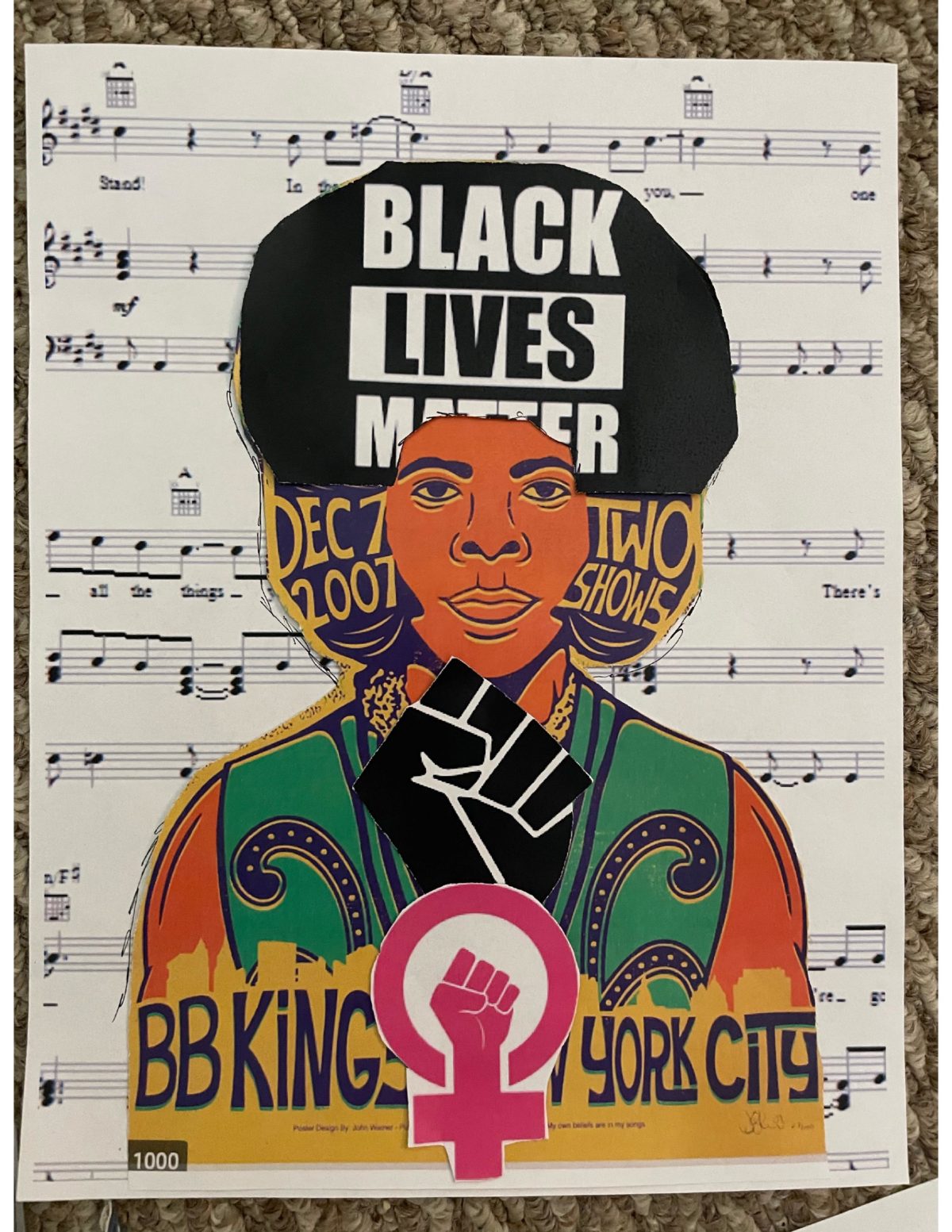The History and Popular Music of the ’60s class learned about Sly and the Family Stone’s infectious 1969 record. Here are their reactions.
Lily Brooks:
The background is the sheet notes for “Stand!” because I love that song and because it’s the first song on the album and the name of the album. I think it represents it well. Then I have a vibrant image of Sly, to represent the high energy from their music. In his hair is the Black Lives Matter flag and on his chest is the fist. I added these because a lot of the songs have to do with racial subjects and I thought it was important. Below the Black Lives Matter fist is the feminism symbol because one thing I love about this band is how diverse it is and how rare it was (and still is) to have a group with both females and men.
Gibson McCoy:
Sly and the Family Stone was one of the first American rock groups to be racially integrated and have both female and male bandmates. Their lyrics tell an important message about being happy while also standing up for yourself. Sly and the Family Stone used fun beats and instruments to attract audiences and then tell them their message about equality. Stand! consists of eight songs. “Everyday People” was their first single that reached no.1. It was a protest song against prejudice. Stand! album eventually sold more than three million copies. “Everyday People,” “Stand!” and “Sing a Simple Song” reached the highest on the charts. This album landed Sly and the Family Stone a gig at Woodstock. As the band moved into the ’70s they released what is considered their best album, There’s a Riot Goin’ On, which moved the band into into darker and less commercial funk sound that they had previously been known for. Later in the 70s the drug problem became too overwhelming and Sly and the Family Stone were forced to disband.
Alex Skiles:
“Everyday People” talks about tensions between black and white, but also between red and yellow and green and blue. To me, this serves to show the absurdity of discrimination based on color. I used photoshop to make a bunch of hands with hippie colors and made them do the hands-joining-together thing, then played around with different blending options.
Sam Swartley:
I’ll be diving into another jam tune, talking about why I like long funk tunes. “Sex Machine” is 15 seconds short of 14 minutes, and takes you on a new kind of journey unlike The Grateful Dead, Jimi Hendrix, Miles Davis or Steve Reich.
The thing that I love about “Sex Machine” is its killin’ bassline, which is pretty much is all you need to know about the tune. The guitar and bass play off each other in a way that is so groovy, with the bass sometimes walking and sometimes going along with that main melody. While the tune follows a traditional blues form, it doesn’t sound like anything you’ve ever heard. Listening to the communication within the band makes everything so much more interesting, hearing when instruments are and aren’t playing I think is definitely something to be aware of. The part that really makes this song so unique is Sly’s voice through what I am guessing is a vocoder. Sly solos with this main melody idea a lot, while also taking the tune pretty far out while the band holds such a tight backing. As soon as you question where the tune is going we are back into the main melody line. This whole transaction happens a few times, Sly going far out and then bringing the tune back. Using this same kind of “form” with different ideas takes tune to such different places while staying true to “Sex Machine.” Now we dive into a killer guitar solo. The twangy tone fills in the gaps within the tune. As we get more into it you can hear a stronger organ chord as the guitar solo phrasing starts to take off. I want to highlight the simplicity of the solo, it’s not a big rush of a bunch of quick notes, it’s well thought out melodies/ideas that have a way of really taking you somewhere. As the guitar player starts making bigger melodic jumps mixed with clean chords you can really appreciate the tone and use of a wah pedal. Now we get a more anthem feel getting more and more powerful. The notes become a bit faster and we start hearing a more low end of the guitar which is interesting because that isn’t common to play a guitar solo in the lower register. This side of the guitar is something often overlooked and is very inspiring.
As we work back up the neck the notes start rolling a bit faster in a surprisingly simple way. Everyone is really groovin’ now. Sly and the guitar player overlap for a second, which is a lot of sounds. Sly takes over of course with his vocoder sound. A new idea is introduced now, with a few of these slick sliding bass fills. Now we hear this distorted new sound (I am guessing a keyboard/organ), a really interesting, overpowering tone. In my mind it’s almost a little too much overwhelming the rest of the band, but it does bring the energy to a new level of grunge and loudness. Towards the end of this solo there’s a cool use of pitch bending that really affects the tone. Right as you think there can’t possibly be anymore energy within this tune we are right back where we started. Sly lazily talking to us through the vocoder, this time everything feels way more relaxed and laid back which is such a good touch. Now we are hit with a pretty clean sax solo, that again is simple and perfect. Then the drums really go off as the saxophone really starts to hit the high notes. The drums overpowering everyone else in a way that I think works beautifully. The song closes with the rest of the band fading out leaving just the drummer playing with time and rhythm. Slowing down the tempo consistently leading the listener on. This continues for around a minute before coming to a complete stop. Silence. Then laughter. The entire band saying “time.” And then probably Sly saying, “We blew your mind.”
These type of funk jams are really interesting to me, though not my favorite, because of the consistency (which is good and bad). To start the tune there is a pretty catchy melodic line, and then everything is based around these 2 to 4 or even 8 bars. In a way it’s a bunch of simple ideas all put together in the perfect way. As easy as it sounds… all the musicianship really pulls it all together. Miles Davis, one of my biggest musical inspirations, was all about this sound in the late ’60s and throughout the ’70s. Specifically albums like Bitches Brew and Tribute to Jack Johnson really came to mind. You could have 20 minutes of a bass player playing the same 4 bars and some drums, go around a room of guitar, keys, horns and that’s a tune! And it’s damn fun to jam like that! This opened a new world of expression and evolved in a way that changed music and mainly jazz. Jazz musicians having this high level of technique and chops over these simple tunes is mind blowing. In my mind, as cool as these funk jams are I feel like basing an entire tune off of one idea can limit where the musicians can take it. Compared to more free form jams like the Grateful Dead (“Dark Star”) there are no limits. This freedom is something special, and allows music to take you anywhere in the world.
Pritam Khalsa:
Sly and the Family Stone had a fun and infectious stage presence and everyone in the audience was always dancing. Part of this was their bright and colorful clothing. They wore very bright and patterned clothing that made the whole experience better. Because trends and fashion are on a cycle, it was interesting to see specific patterns and styles that I would wear now or that I have seen other people wearing. Sly had a pair of patchwork jeans, many of them wore flared pants, and they wore lots of leopard print. I decided to draw their logo but with all of the fabric and patterns as the letters.



